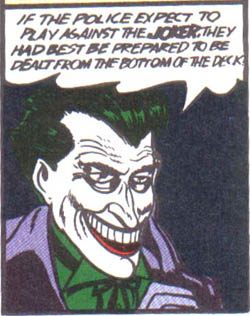How Victor Hugo Helped Create The Joker
The most frightening Joker of all was the very first. (Photo: Youtube)
The new Suicide Squad trailer was released this week, giving us a glimpse of cinema’s latest version of The Joker. This latest iteration, played by a heavily tattooed Jared Leto, joins a long line of cinematic Jokers, each with their own quirks. However, the Joker did not begin as a scribble at DC Comic, as is commonly thought. In fact, the notorious laughing villain can be traced back to a silent film character from the late 1920s, that was inspired in turn by a Victor Hugo novel published in 1869.
This tragic silent film clown served as a clear template for the later comic book villain. Hugo’s book, The Man Who Laughs, is a sad story about an orphan in the 17th century. The protagonist, Gwynplaine, is of secret and portentous parentage, and was hideously disfigured as a child, resulting in a permanent rictus that makes him look like he is perpetually laughing. Gwynplaine is raised by a drifter and his pet wolf, using his permanent smile as a smashing punchline to their traveling stage show.
Of course, as often happens in such stories, Gwynplaine turns out to be of royal lineage, having been sold to a band of child-nappers who disfigure their victims to use them in sideshows, all as part of a despicable political scheme. Once Gwynplaine’s true identity is revealed, he becomes embroiled in the intrigues of his new role as a Marquis, but his grotesque grimace proves to be his downfall–no one takes him seriously. At last, Gwynplaine renounces his station and tries to reconnect with his old family of drifters, but sadly, when he finally does, the love of his life dies, and he throws himself into the sea. The Man Who Laughs never quite made it into Hugo’s canon of classics. It is a pretty astounding downer.

Dear god, Gwynplaine. (Photo: Youtube)
Despite the novel’s middling reputation, it was adapted into a 1928 silent film, also called The Man Who Laughs. Envisioned and directed by German Expressionist Paul Leni, the film took its 17th century setting and characters and turned them into stark, foreboding caricatures. Even for a black and white film, it is filled with darkness, often punctured only by the pale, ghoulish skin of the actors and actresses in the frame. Ultimately it turns Hugo’s tragic story of love and politics into something resembling a horror movie.
Of course, no one in the film stands out more than Gwynplaine, played by the famous actor Conrad Veidt, formerly the star of the The Cabinet of Dr. Caligari. Veidt portrayed Gwynplaine with a permanent distended grin that did not look so much like a deformity, as it did a violent madness, even in the scenes where he was simply being sad. This is especially true of a scene where Gwynplaine reveals his rictus to an adoring crowd and the camera simply focuses on close ups of Veidt’s exaggerated expression.
Watch the scene below; nightmare warnings on.
Even though Leni altered Hugo’s ending so that both Gwynplaine and his lady love survive and sail off into a happy future together, upon release, the movie was seen as overly grim, and failed to light the silver screen on fire. But its legacy was far from over.
Cut to 1940. Comic book creators Bob Kane, Bill Finger, and Jerry Robinson are about to make history by spinning off popular Detective Comics character, Batman, into his own magazine of stories. Written by Finger, and featuring art from Kane and Robinson, Batman #1 featured a quintet of stories starring the Caped Crusader. Two of these stories centered on a sinister new villain named The Joker (another introduced Catwoman). The depiction of the white-skinned, green-haired killer was unsettling even in his somewhat crudely illustrated first appearance, and it owed it all to Veidt’s look in The Man Who Laughs.

The Joker as drawn by Bob Kane in Batman #1 (Photo: Wikipedia)
While the similarities are visually apparent on first glance, the visual inspiration was later confirmed by both Kane and Robinson, although opinions differed on who came up with the character. According to an article on Den of Geek, Kane said in a 1994 interview:
Bill Finger and I created the Joker. Bill was the writer. Jerry Robinson came to me with a playing card of the Joker. That’s the way I sum it up. But he looks like Conrad Veidt—you know, the actor in ’The Man Who Laughs’…So Bill Finger had a book with a photograph of Conrad Veidt and showed it to me and said, ‘Here’s the Joker.’”

(Photo: Youtube)
In the decades since The Joker’s creation, the character has been portrayed as everything from a schizophrenic transexual to a scenery-chewing, murderous mastermind. But at the root of the Joker’s iconic evil is the tragic irony of Hugo’s grinning grotesque, and the performance that brought it to life.











Follow us on Twitter to get the latest on the world's hidden wonders.
Like us on Facebook to get the latest on the world's hidden wonders.
Follow us on Twitter Like us on Facebook